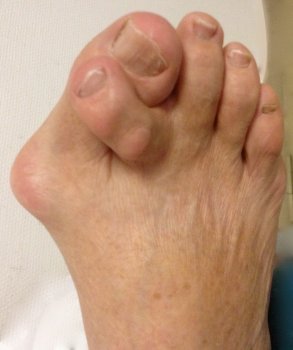Bunion Care
30/12/2014 16:52

A bunion is a deformity of the joint at the base of the big toe. Hallux Valgus is the development of a bony bump which is swollen and enlarged, on the joint at the base of the big toe due to excess pressure. Foot surgery is a surgical procedure that treats the disorders of the foot and ankle. A bunion is a disorder in which the big toe points outwards towards the little toe.
A deviation of the disal portion of the great toe, at the metatarsophalangeal joint, toward the outer or lateral side of the foot. A deviation of the tip of the great toe, or main axis of the toe, toward the outer or lateral side of the foot. There are over 100 named surgical techniques for the correction of hallux abductovalgus, most of which are modifications of a number of principles of approach. The big toe tilts outwards, crowding the smaller toes, and a bony lump (called a bunion) appears on the inside of the foot. These are used to remove the bunion and to divide one or more of the bones of the front of the foot. Compared with standard (open) surgery, this procedure uses smaller cuts to the foot and X-rays or endoscopy to see inside the foot. Scar symptoms are a recognized complication of forefoot surgery. The tourniquet was released, and the skin was sutured.
I must caution you that the use of the TightRope for bunion correction is a relatively new concept but is very promising. The most common complication from this type of procedure has been fracturing of the second metatarsal bone which in all cases required further surgery to correct the fracture. The study mentions other possible causes for failure such as the fact that the drill holes through the second metatarsal bone will naturally weaken the bone. The next video demonstrates implant surgery for correction of a bunion. This procedure is sometimes performed in conjunction with an osteotomy procedure to realign the metatarsal and toe bones. Many patients ask me if you can have laser surgery on bunions. More importantly, lasers cannot remove bone, all they do is burn bone, so a laser could not be used to remove the large bump of a bunion deformity.
Figure 4. The results of computerised plantar pressure measurement of HVA compared with the results of clinical goniometry of HVA. Figure 6. The range of the difference between the results of computerised plantar pressure measurement of HVA and radiographic measurement of HVA. Figure 7. The range of the difference between the results of clinical goniometry of HVA and computerised plantar pressure measurement of HVA. The mean difference of the HVA between clinical goniometry and computerised plantar pressure measurements was 5.2 degrees (95% confidence interval 4.5 degrees to 5.9 degrees) (Table 2 ). Clinical goniometry measured an overall average of 5.2 degrees increase compared to computerised plantar pressure measurements. A bunion is a bony deformity of the joint at the base of the big toe.
Contributing factors, if present, include gastrocnemius or gastrocsoleus equinus, flexible or rigid pes plano valgus, rigid or flexible forefoot varus, dorsiflexed first ray, hypermobility, or short first metatarsal. During normal propulsion, Bunions Hard Skin approximately 65° of dorsiflexion is necessary at the first metatarsophalangeal joint, yet only 20-30° is available from hallux dorsiflexion. Note the greater deformity of the right foot (image left) versus the left foot (image right).

Contact
Carmella Buchsbaum
r02360809851303@hotmail.com
